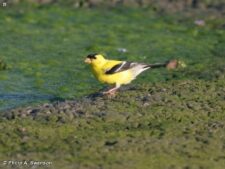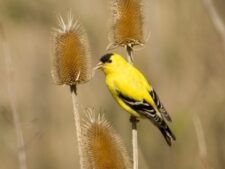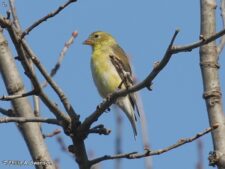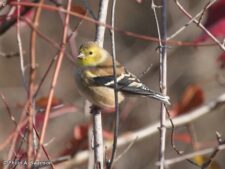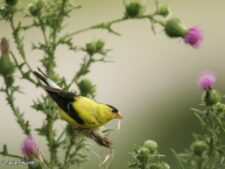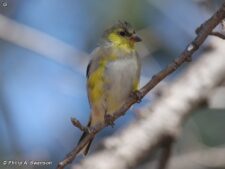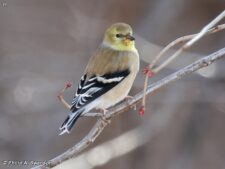
5.0 inches long. The American Goldfinch is a small seed eating bird with a short conical bill and a short forked tail. The adult male in breeding plumage is a bright yellow bird with a black forehead. The wings and tail are black. The wings have white wing bars. The rump and undertail are white. The breeding female has much more subdued colors. She has greenish upperparts and yellow underparts. The American Goldfinch is quite different in non-breeding plumage. The face is yellow but the upperparts become brownish-olive. The underparts are whitish and the wings are dark with pale wing bars. The juvenile bird has even less coloration.
The American Goldfinch is a common breeder and permanent resident in the Forest. It can be easily seen along the Stream Trail and in winter at the Forest feeders.
The American Goldfinch is often called the “Wild Canary”. It is common in summer in weedy fields, river flood plains, early second growth forest, and orchards and suburban gardens. Many northern populations migrate but some may not. Wintering flocks are nomadic, their movements closely tied to food supply. During the winter months the species is common at bird feeders. It is especially fond of niger thistle. This species is also unusual because it is one of the latest breeders of all temperate zone song birds. It normally waits to nest until late June or early July. There is a close relationship between the flowering of thistles, an important food plant, and the start of nest building. The nesting season is a short one. As a result, most pairs have time to produce only one brood in a season, although experienced breeders frequently produce two broods if eggs are laid early and the first brood is successful. To permit a second nesting, a female must abandon the first brood to her mate, and then leave to find another mate. The American Goldfinch eats seed almost exclusively. This diet may explain why the Brown-headed Cowbird fails to survive in goldfinch nests. Even though cowbirds hatch successfully, their growth is retarded and almost all die before they can leave the nest. The American Goldfinch commonly gives its distinctive “per-chick-oree” call while making its undulating flight that alternates several rapid wing beats with wings pulled to its sides. The call is series of high sweet phrases “towee, towee, towweeto, tweer, tweer, tweer, ti, ti, ti”.
Disclaimer: The content of NatureSearch is provided by dedicated volunteer Naturalists of Fontenelle Forest who strive to provide the most accurate information available. Contributors of the images retain their copyrights. The point of contact for this page is: Phil Swanson.

